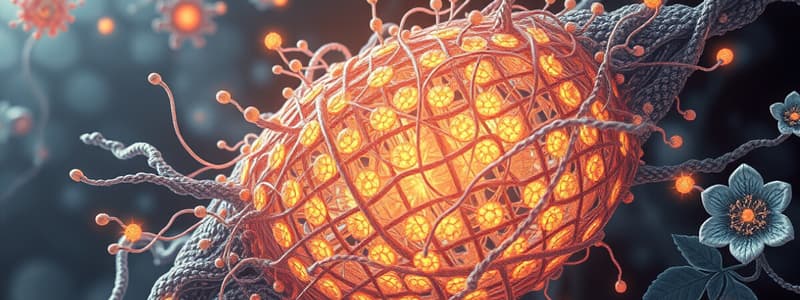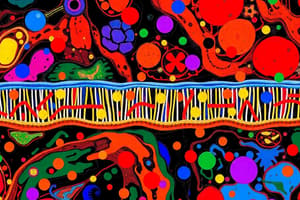Podcast
Questions and Answers
What is the primary role of aquaporins in facilitated diffusion?
What is the primary role of aquaporins in facilitated diffusion?
- They transport ions selectively based on charge.
- They allow water molecules to move across membranes. (correct)
- They facilitate the movement of lipid-soluble substances.
- They increase the viscosity of water.
Which statement best describes leak channels in facilitated diffusion?
Which statement best describes leak channels in facilitated diffusion?
- They are only present in lipid membranes.
- They are always open, allowing continuous flow. (correct)
- They selectively transport large polar molecules.
- They only open in response to electrical signals.
How does osmosis differ from other forms of diffusion?
How does osmosis differ from other forms of diffusion?
- It primarily concerns the movement of water across membranes. (correct)
- It does not rely on concentration gradients.
- It occurs only in the presence of a protein channel.
- It involves both solute and solvent movement.
What makes channel-mediated facilitated diffusion different from simple diffusion?
What makes channel-mediated facilitated diffusion different from simple diffusion?
Why can small polar molecules sometimes diffuse through the lipid bilayer?
Why can small polar molecules sometimes diffuse through the lipid bilayer?
What is the primary role of epithelial tissue in the body?
What is the primary role of epithelial tissue in the body?
What factor primarily influences the flow of water during osmosis?
What factor primarily influences the flow of water during osmosis?
What distinguishes exocrine glands from endocrine glands?
What distinguishes exocrine glands from endocrine glands?
Which type of specialized epithelium is found lining blood vessels?
Which type of specialized epithelium is found lining blood vessels?
What kind of signals regulate gated channels in facilitated diffusion?
What kind of signals regulate gated channels in facilitated diffusion?
Which of the following is NOT a characteristic of channel-mediated facilitated diffusion?
Which of the following is NOT a characteristic of channel-mediated facilitated diffusion?
The interior space of a hollow organ is referred to as what?
The interior space of a hollow organ is referred to as what?
What is the relationship between epithelial cells and glandular tissue?
What is the relationship between epithelial cells and glandular tissue?
What occurs when two solutions of different osmolarity are separated by a semi-permeable membrane?
What occurs when two solutions of different osmolarity are separated by a semi-permeable membrane?
In the case of a membrane that is permeable to water but impermeable to solutes, what happens to the volume of the compartments?
In the case of a membrane that is permeable to water but impermeable to solutes, what happens to the volume of the compartments?
Which statement accurately describes osmolarity in a state of equilibrium?
Which statement accurately describes osmolarity in a state of equilibrium?
What is the role of water in the process described in the content?
What is the role of water in the process described in the content?
Which of the following conditions is necessary for osmosis to occur?
Which of the following conditions is necessary for osmosis to occur?
How does a hyperosmotic solution affect surrounding cells?
How does a hyperosmotic solution affect surrounding cells?
What defines primary active transport?
What defines primary active transport?
What happens to solute molecules during the process of osmosis when the membrane is permeable only to water?
What happens to solute molecules during the process of osmosis when the membrane is permeable only to water?
Which statement is true regarding secondary active transport?
Which statement is true regarding secondary active transport?
Which statement best describes the condition of the solution with lower osmolarity?
Which statement best describes the condition of the solution with lower osmolarity?
In a hypertonic solution, what happens to the water movement relative to the cell?
In a hypertonic solution, what happens to the water movement relative to the cell?
In terms of osmosis, what is the final outcome for the compartments involved after equilibrium is achieved?
In terms of osmosis, what is the final outcome for the compartments involved after equilibrium is achieved?
What does the term 'isotonic' imply in the context of osmotic solutions?
What does the term 'isotonic' imply in the context of osmotic solutions?
Which mechanism primarily changes the shape of a carrier protein in primary active transport?
Which mechanism primarily changes the shape of a carrier protein in primary active transport?
What is the primary driving force for secondary active transport?
What is the primary driving force for secondary active transport?
Which of the following statements regarding solute movement in hypertonic solutions is correct?
Which of the following statements regarding solute movement in hypertonic solutions is correct?
What effect does primary active transport have on cellular homeostasis?
What effect does primary active transport have on cellular homeostasis?
Which of the following is an example of a substance moved by primary active transport?
Which of the following is an example of a substance moved by primary active transport?
How does ATP hydrolysis contribute to solute transport?
How does ATP hydrolysis contribute to solute transport?
What role do carrier proteins play in active transport mechanisms?
What role do carrier proteins play in active transport mechanisms?
Which type of muscle tissue is responsible for involuntary movements in blood vessels?
Which type of muscle tissue is responsible for involuntary movements in blood vessels?
What is a key characteristic of connective tissue compared to the other tissue types?
What is a key characteristic of connective tissue compared to the other tissue types?
What functional role do skeletal muscle cells primarily play?
What functional role do skeletal muscle cells primarily play?
Which of the following structures is classified as connective tissue?
Which of the following structures is classified as connective tissue?
What is the primary function of cardiac muscle cells?
What is the primary function of cardiac muscle cells?
Which characteristic is true about smooth muscle cells?
Which characteristic is true about smooth muscle cells?
What serves as the basis for electrical signals in muscle cells leading to contraction?
What serves as the basis for electrical signals in muscle cells leading to contraction?
Which type of cell is primarily involved in the formation of tendons?
Which type of cell is primarily involved in the formation of tendons?
What is the function of blood cells classified under connective tissue?
What is the function of blood cells classified under connective tissue?
What role does the extracellular matrix play in connective tissue?
What role does the extracellular matrix play in connective tissue?
Flashcards are hidden until you start studying
Study Notes
Facilitated Diffusion
- Facilitated diffusion utilizes transmembrane proteins to form channels with aqueous cores, allowing transport of molecules like ions and water.
- Specificity in facilitated diffusion is determined by the pore size and charge of the channels.
- Aquaporins are specialized channels that facilitate water transport.
- Two types of channels:
- Leak channels, which remain open at all times.
- Gated channels, which open or close in response to chemical or electrical signals.
Osmosis
- Osmosis is the movement of water across a selectively permeable membrane, driven by differences in water concentration.
- Water can diffuse through the plasma membrane via:
- Lipid bilayer due to small size, despite being polar.
- Aquaporins for facilitated transport.
- Equilibrium occurs when solute and water concentrations are balanced on both sides of a membrane.
- Membranes permeable only to water and not to solutes create a situation where water moves to equalize osmolarity while solutes remain stationary.
Active Transport
- Active transport involves the movement of substances against their concentration or electrochemical gradients.
- Divided into:
- Primary active transport, which directly uses ATP for energy.
- Secondary active transport, which relies on the energy stored in electrochemical gradients to transport other solutes.
Primary Active Transport
- Energy from ATP hydrolysis alters the shape of carrier proteins (pumps) to move solutes across membranes against gradients.
Muscle Cells and Muscle Tissue
- Muscle cells contract to generate mechanical force and facilitate movement.
- Electrical signals trigger muscle contractions.
- Types of muscle tissue:
- Skeletal muscle: voluntary control (e.g., arms, legs).
- Cardiac and smooth muscle: involuntary control (e.g., blood vessels).
Connective Cells and Connective Tissue
- Connective tissue is the most diverse cell type, characterized by an extracellular matrix.
- Functions include anchoring and attaching body structures.
- Types of connective tissues include bone, tendons, fat, and blood cells.
Epithelial Cells and Epithelial Tissue
- Epithelial tissue forms sheet-like layers, lining internal surfaces and cavities as well as hollow organs.
- Specialized epithelium in blood vessels is known as endothelium.
- Major functions include providing barriers for protection and forming glandular tissues to produce secretions.
- Types of glands:
- Exocrine glands, which have ducts (e.g., sweat, salivary glands).
- Endocrine glands, which lack ducts and secrete hormones directly into the bloodstream.
Studying That Suits You
Use AI to generate personalized quizzes and flashcards to suit your learning preferences.




